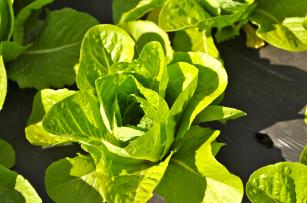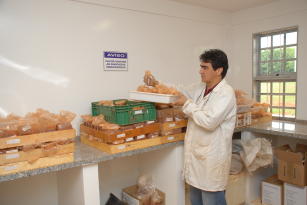The search for natural-based herbicides
The search for natural-based herbicides
Studies conducted by Embrapa Environment indicate that plants such as Imperata cylindrica (also known as blady grass) have compounds that inhibit the growth of other plants. Extracted by solvents, these compounds will be tested in different concentrations to check their level of effectiveness. Research has tried to combat the evolution of pest and disease resistance to pesticides.
Antônio Cerdeira from Embrapa Environment explains that Embrapa does not aim to create new herbicides. The initial task is to isolate biocompounds from specific plants, with herbicide potential. The expected result is the development of models to create new natural chemical herbicides. Herbicides that are in fact more efficient, less persistent in the environment, and less toxic than commercial products currently available on the market.
Nowadays herbicide-resistant weeds have moved into areas of cultivated fields in Brazil and threaten the advantageous zero tillage system, especially in soybean and corn crops. Monocultures and the continuous use of a single herbicide formulation for decades have contributed to the natural selection of resistant or tolerant plant biotypes that infest fields and negatively affect profitability on farms.
The invasive plants that concern researchers the most are horseweed (Conyza bonariensis and Conyza canadenses), ryegrass (Lolium multiflorum) and sourgrass (Digitaria insularis), which have a high spreading power. A single horseweed plant, for example, can produce up to 200,000 seeds with features and structures that are easily dispersed by the wind, which characterizes it as an aggressive species in terms of infestation. The plant can interfere in a very expressive way in the yield and hence the profitability of the crop.
Infestations, even in a lesser extent, of the order of six to ten individuals per m²/ha, for example, correspond to half a ton of grains less in the trade balance. The math is simple: the more weeds in the field, the lower the productivity.
Antônio Luiz Cerdeira, a researcher at Embrapa Environment, believes that producing grains will become a task involving more and more work and resources. "We may be putting aside the practicality of zero tillage, with the use a single herbicide in weed control, for a more complex, laborious and costly system to produce grain", he explains. For him, the farmer needs to understand that it is no longer the time to leave weeds growing, then only apply herbicide when it seems appropriate and "have the problem be solved as if it was by magic."
Research program
The high rate of interference of certain plants, in competition for natural resources with neighboring plants (water, light and nutrients) becomes the villains of crop fields. Popularly called "weeds", they infest growing areas, interfering with food production.
For decades, glyphosate was treated as the most efficient and successful chemical herbicide in the market to control unwanted plants. What was once the final solution for agriculture in the past does not have the same efficiency today. It is time to find new alternatives to confront resistant weeds.
Embrapa Environment (SP) and Embrapa Soybean (PR) have been jointly conducting research to find compounds with herbicidal potential and with the use of allelopathy - the ability of plants which were introduced in a given environment to influence the plants that had previously been there. Conceptually, they are chemical compounds which the plant exudes ("breathes") and that are capable of interfering with the growth of other plants. In addition to the allelopathy research, alternative practices with chemical and crop weed control are also conducted.
The work integrates with a broader system of research, Sustensoja - Integrated strategies for technology generation for sustainability of the soybean production chain.
According to Dionísio Gazziero, at Embrapa Soybean, it is possible to have answers about the allelopathic effects of a particular component within various soil conditions and weather, for instance, or within a certain program. "After allelopathic inhibitory effects of a given plant are suspected in the field, assessments are made in the laboratory. Once the pattern of the effect observed is validated, the compounds will be tested in the field," he explains.
The research includes assessments for the integrated crop-livestock-forest system environment and systems with other crops in which soybean is one of the components. This makes it possible to determine the rate of interference that the forest plays in the field, either due to physical reasons or allelopathic interference.
Investments in research equipment
According to Celso Manzatto, head of Embrapa Environment, the moment requires efforts both to halt the invasion of resistant weeds in crops as in the proposition of new control concepts, backed by scientific research. He says that Embrapa's response to this challenge, at first, was based on sending researchers Sônia Queiroz and Lourival Paraíba abroad to have contact with international studies conducted at other institutions. In a second stage, the concern was to enlist scientific partnerships at national and international level.
Manzatto emphasizes Embrapa's acquisition of high technology equipment for capture and image processing applications. They allow to evaluate bioassays aimed at the discovery of compounds for use in agriculture. "Composed of hardwares and softwares, sensors and camera systems, our laboratory has become a model in the exploitation of microbial diversity as well as a deposit of microbial resources," says the researcher.
English proofreading: Mariana Medeiros
Marcos Vicente (MTb 19.027/MG)
Embrapa Environment
Press inquiries
meio-ambiente.imprensa@embrapa.br
Phone number: +55 19 3311.2611
Further information on the topic
Citizen Attention Service (SAC)
www.embrapa.br/contact-us/sac/



